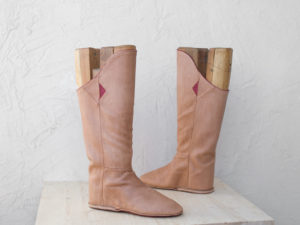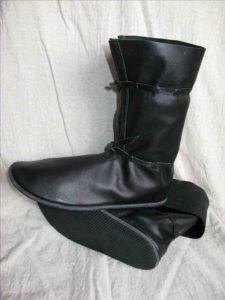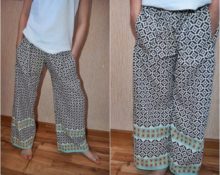For adults with very small or, conversely, large feet, it can be very difficult to choose autumn or winter shoes. Those who wear sizes 34-35 have to go to children's stores for new clothes, giants with 45-46 may not find a suitable pair at all. An excellent way out would be to sew your own boots, which will definitely meet all your needs and wishes.
What you need to sew boots
 To sew your own boots you will need lasts. You can purchase ready-made shoe lasts, which differ from shoe lasts in the presence of padding for sewing the boot. For those who want to customize their future boots as much as possible, you can make the last yourself. To do this, you need to lower your foot into a container filled with impression mass and remove it only after the substance has completely hardened. You need to pour casting material into the resulting cast and wait until the block hardens.
To sew your own boots you will need lasts. You can purchase ready-made shoe lasts, which differ from shoe lasts in the presence of padding for sewing the boot. For those who want to customize their future boots as much as possible, you can make the last yourself. To do this, you need to lower your foot into a container filled with impression mass and remove it only after the substance has completely hardened. You need to pour casting material into the resulting cast and wait until the block hardens.
Important! The finished layout must be wrapped with wide masking tape, which will prevent splitting and allow markings and drawings to be applied to the block.
In addition to lasts, to sew boots you will need:
- Leather, fabric and rubber that will become the basis for shoes. It is better to purchase them with a reserve - several sheets of each material.
- Sole. For the first time, you can use strong soles from old boots that are out of fashion or simply no longer liked by their owner. If you don’t have one, you can use cork as a material for making a new sole, which will make it water-repellent and durable.
- Sewing tools. Needles, threads, scissors, a knife, a sharp awl and shoe nails are among the tools necessary for sewing shoes.
- Paper, tailor's yardstick and pattern pen, glue.
You can purchase tools and consumables in specialized stores all together, or separately in supermarkets or at the market. It is important to consider that shoe leather is much different from the leather used to make clothes and bags; it is very hard and dense.
How to make a pattern for boots
 After the block is ready, you need to start creating a pattern. The easiest way to make an insole is to draw it along the contour of the foot. It is important to take into account the shape of the sock and the fact that the finished shoe should be slightly longer than the foot itself.
After the block is ready, you need to start creating a pattern. The easiest way to make an insole is to draw it along the contour of the foot. It is important to take into account the shape of the sock and the fact that the finished shoe should be slightly longer than the foot itself.
The construction of the pattern for the upper part of the boots begins with measuring the foot in several places. For this, it is best to use a flexible tailor's meter. Having the results of measurements before your eyes, you can draw a shape. It is also necessary to measure the height of the backdrop.
The external and internal parameters must coincide with the external and internal contours of the insole; if this is not followed, it will be difficult to sew the shoes.To build a cutout you need to measure the depth from the toe to the instep. To construct a schematic image of the boot, you need to measure its width in several places, taking into account the lock, and then draw a part of the required length.
Important! Paper patterns need to be applied to the foot or last. If you need to make a looser fit, the pattern can be made a little wider. In this case, you will need to select a lining under the top layer of leather.
How to sew boots with your own hands: instructions
 After the patterns have been cut out from the pattern, they are transferred to the leather, from which parts of the future boot are cut out using a knife:
After the patterns have been cut out from the pattern, they are transferred to the leather, from which parts of the future boot are cut out using a knife:
- Sole blanks cut from thick leather are applied to the last. A leather upper blank is attached to it using nails by pulling it onto the last.
- After the top is fixed, the junction with the sole is glued with a layer of glue. After this, you can remove the nails, trim off the excess material and glue the cardboard edging.
- The second part of the sole (finished or made from cork) is attached to the top with glue, firmly connecting them together. For a stronger grip, they can be lightly beaten with a hammer.
- The remaining parts of the top are sewn together with an even and neat seam. In order for the seams to be as even as possible, you must first make the required number of punctures in the material and only after that use a needle and thread.
- A zipper is sewn into the boot, or if the boots are short, holes are made in the boot for the laces.
- To ensure that boots can be worn in rain and wet snow, they must be treated with water-repellent impregnation or cream.
In order for two boots from the same pair to be as similar to each other as possible, work on them must be carried out in parallel.


 0
0





